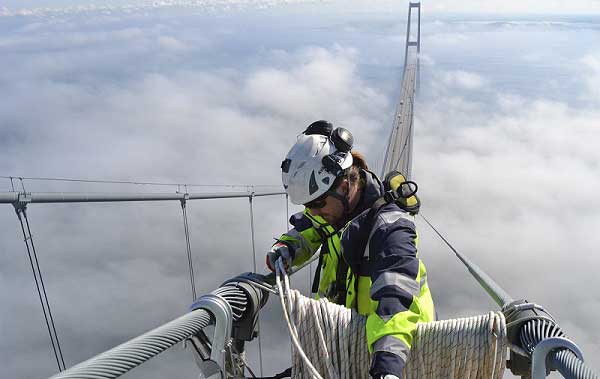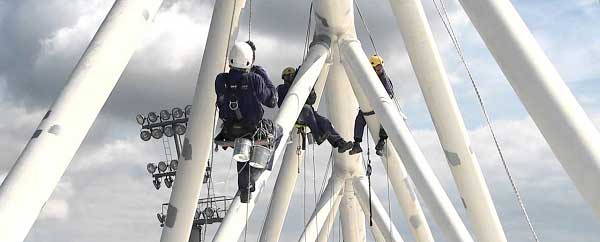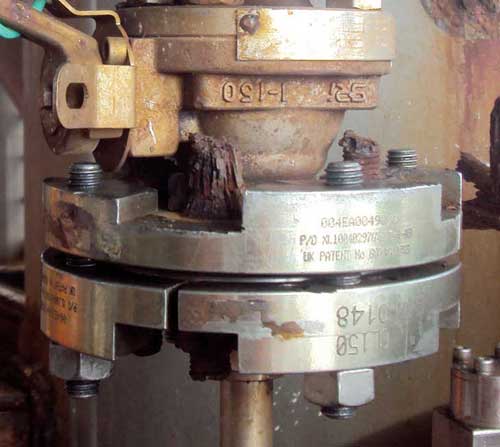What Is Rope Access?
The primary purpose of rope access is to give workers access to hard-to-reach areas without scaffolding, wires or aerial platforms.
Rope access is the professional use of ropes to perform inspections, maintenance and other types of work.
 Image..
https://irata.org
Image..
https://irata.orgA rope access technician uses ropes to descend, ascend or climb through ropes while being held in place by a harness, and sometimes by a rope access work chair.
Rope access was first used for industrial work in the 1980s. Since then, professional associations such as IRATA (Industrial Rope Access Trade Association), SPRAT (Society of Professional Rope Access Technicians) and other associations have codified it and made it a proven, reliable method of getting people to work in hard-to-reach places.
Today, there is a wide range of rope access work and jobs involving rope access.
In the civil sector, the most common applications include window cleaning, maintenance and support.
In the industrial sector, the most common applications are inspections like non destructive testing (NDT).
To meet rope access safety requirements, rope technicians typically use a few different redundancies to ensure they are still safe if some part of their equipment fails.
Two common redundancies are..
- A backup fall protection system, which uses two ropes to provide redundancy for safety - a working rope and a safety rope.
- Additional anchor points - a primary anchor point and two backup anchor points.
The biggest advantage of using access ropes lies in the speed and safety with which workers can reach hard-to-reach areas to perform their work, often with minimal impact on other work and surrounding areas.
When comparing the man-at-risk hours and associated risks and costs of accessing such locations with other means of access, rope access generally reduces both the time workers are exposed to risk and the degree of that risk.
 Image..
https://rt9.dk
Image..
https://rt9.dk Rope Access Equipment List
There are many different types of equipment used in rope access work. Much of this equipment is explicitly designed to meet rope access safety requirements and allow inspectors to work safely.
Here are the most common types of rope access equipment..
ASCENDERS
- A ascender allows you to climb ropes. This type of hitch works like a friction hitch, sliding along the rope while it is empty and locking into place when weight is applied. Unlike friction hitches, crampons are mechanical and are safer and much easier to use.
DESCENDERS
- Workers or loads are lowered using descent levers to do so at a controlled speed. This is done using friction, much like crampons. Descenders must have a self-braking mechanism and a mechanism to release the operator.
LIFELINES / ENERGY ABSORBERS
- Harnesses are attached to anchors with lifelines and energy absorbers. A fall arrest system is the most commonly used type in the industry and is designed to reduce the force on the body in the event of a fall.
HARNASSES
- Types of harnesses used in rope access are full harnesses and seat harnesses. Full harnesses are more often used in rescue operations or industrial applications because of the number of attachment points.
HELMETS
- Helmets provide protection from falling debris and other head hazards associated with rope access. Although safety harnesses are mandatory on all construction sites, they are especially important when working at height. This is essential to prevent orthostatic hypotension due to restricted blood flow if a worker suffers an accident that leads to loss of consciousness.
ROPES
- Without ropes, there would be no access through ropes. Ropes are not only strong, but also light and flexible.
Many other equipment used in rope access - include connectors, foot loops, mobile fall arrest devices and pulleys.
 Image..
www.eurosafesolutions.nl
Image..
www.eurosafesolutions.nl ADVANTAGES & DISADVANTAGES OF ACCESS VIA ROPES
ADVANTAGES
Accessibility - A rope access solution can always be found to reach an "inaccessible" place, whether it is in height or depth. Safety. Working at height is generally a safe activity if performed according to IRATA guidelines.
Speed - A rope access system can be set up and taken down quickly. As a result, it can be set up and taken down quickly when needed. There is little inconvenience.
Space - Compared to other methods of reaching hard-to-reach places at height, rope access takes up very little space, meaning it does not significantly disrupt a work site.
Environmental considerations - Rope methods are considered environmentally friendly because they do not require the transportation of large machinery and because they allow people to reach work sites without clearing or modifying land.
DISADVANTAGES
Perception - Although rope access is generally safe, many companies are still wary of it because of the perception that it is dangerous.
Access - Ropes do not allow access to every area where someone needs to be for work.
Directional restrictions - Access systems with lines are not powered, meaning a technician can only go down and not back up.
Limitations in maintenance work - Working with ropes limits a person's ability to perform certain types of maintenance work, making some types of more intensive work impossible.
TRAINING FOR ROPE ACCESS
The training and qualifications required to get started with rope access can seem daunting - and with good reason.
Working with ropes is inherently dangerous. That's why much emphasis is placed throughout the industry on rope access safety requirements and the training to meet them.
Both IRATA and SPRAT have mandatory training policies and strict reporting requirements for all members.
CERTIFICATION LEVELS
There are three widely recognized levels of certification for rope access training, each with different content and criteria.
Here is how these three technical degrees are described by IRATA..
Level 1 - This level covers a variety of rope access maneuvers, rigging equipment inspection and basic rescue procedures.
Level 2 - This level builds on Level 1 training and teaches rope rigging, safety regulations, rescues and quality assurance procedures.
Level 3 - This level teaches the most advanced rescue techniques and best practices, and enables rope technicians to work as site supervisors. A Level 2 supervisor must complete 1000 hours of rope work before earning Level 3 certification.
In addition to training, a candidate's health, fitness, strength and coordination levels may also be considered as part of the certification process.
References..
www.pacificropes.com
www.flyability.com
Related Post(s)

While hot bolting is the more commonly used term, this can be misleading as the procedure Is Not Always Carried Out At a Hot Temperature...